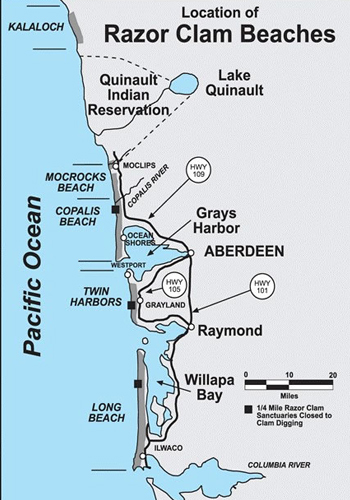Can You Dig It?
The first razor clam dig of the fall season will get underway Oct. 11 – Oct. 13, as various beaches, including Seabrook beaches.
The Washington Department of Fish and Wildlife (WDFD) has approved the dig on evening tides at Mocrocks, Copalis, and Twin Harbors after marine toxin tests showed that clams on those beaches are safe to eat. No digging is allowed on any beach before noon.
The upcoming dig is approved on the following beaches, dates, and evening low tides:
- October 11, Thursday, 8:58 p.m.; -0.6 feet; Mocrocks, Twin Harbor
- October 12, Friday, 9:41 p.m.; -0.3 feet; Copalis, Twin Harbor
- October 13, Saturday, 10:26 p.m.; +0.1 feet; Mocrocks, Twin Harbor
Dan Ayres, WDFW coastal shellfish manager, recommends that diggers hit the beach about an hour or two before low tide for the best results.
Diggers want to be sure to come prepared with good lighting devices and always keep an eye on the surf, particularly in the fall when the best low tides come after dark, he added.
“Digging after dark brings with it the spectacle of thousands of small lights representing individual razor clam diggers working their way up and down the beach,” said Ayres.

All diggers age 15 or older must have an applicable 2018-19 fishing license to harvest razor clams on any beach. Licenses, ranging from a three-day razor clam license to an annual combination fishing license, are available on WDFW’s website at https://fishhunt.dfw.wa.gov and from license vendors around the state.
Under state law, diggers at open beaches can take 15 razor clams per day and are required to keep the first 15 they dig. Each digger’s clams must be kept in a separate container.
Where to Dig
Seabrook’s beaches are ideal for digging clams. The actual name for the beach located directly in front of Seabrook is Mocrocks, and Copalis is south of that.
Mocrocks: Extends from the Copalis River to the southern boundary of the Quinault Reservation near the Moclips River, including Seabrook, Iron Springs, Roosevelt Beach, Pacific Beach, and Moclips.
Copalis: Extends from the Grays Harbor north jetty to the Copalis River, and includes the Copalis, Ocean Shores, Oyhut, Ocean City and Copalis areas.
How to Dig Razor Clams
First look for a “clam show”. What is a clam show? That’s where a clam has withdrawn its neck or started to dig leaving a hole or dimple in the sand. There are three major kinds of “shows” to look for:
- dimple: a depression in the sand
- doughnut: which has raised sides
- keyhole: which is usually in drier sand areas and is shaped like an “hour-glass” or is a hole with very distinct sides.
Always look for the larger sized hole as this is a good indication that the clam will be larger, but not always.
Clams will also show at the edge of the surf line when you pound the beach with a shovel handle or your foot. They may squirt sand and water out of the hole where they are located. You need to be quick when digging in the surf as razor clams dig really fast in the soft fluid sand.
